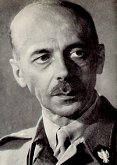Prominent Poles
Tadeusz Bor-Komorowski (count, coat of arms Korczak), military man, commander of AK (Armia Krajowa = Home Army), prime minister of Polish Government in Exile

Born: June 1, 1895, Chorobrow, Austro-Hungarian partition of Poland (presently Ukraine)
Died: August 24, 1966, Buckley, England
Early days.Father: Mieczyslaw Marian Komorowski. Mother: Wanda Zaleska-Prawdzic.
Military carreer till WWII. General Count Tadeusz Komorowski better known by the name Bór-Komorowski (Bór being his wartime code-name; other code-names: Korczak, Lawina, Znicz), was a Polish military leader. During the First World War he was an officer in the Austro-Hungarian Army, and after the war served as an officer in the Polish Army, becoming commander of the Grudziadz Cavalry School . During the occupation Grudziadz was a location for the German concentration camp Graudentz that was a subcamp of the concentration camp Stutthof.
Marriage. In 1930 Komorowski married Irena Lamezan-Salins.
Organizer of Polish underground. After taking part in the fighting against the German invaders in 1939, Komorowski was one of the organizers of the Polish underground in the Cracow (Krakow) area.
Commander of AK. In July 1941 he became deputy commander of the Home Army (AK), and in March 1943 was appointed its commander, with the rank of Brigadier-General (replacing its previous commander, General Grot-Rowecki, arrested by the Gestapo and executed in 1944). The Home Army consisted of about 400,000 soldiers and was composed of 19 divisions: 6 in the districts of Eastern Poland (presently parts of Lithuania, Belarus and Ukraine) and 13 in the districts of Central Poland including 3 in the Warsaw district.
Warsaw Uprising 1944. In mid 1944, as the Soviet forces advanced into central Poland, the Polish government-in-exile in London instructed Bór-Komorowski to prepare for an armed uprising in Warsaw, so that the government could return to a city liberated by Poles and not by the Soviets, and prevent the Communist take-over of Poland which Stalin was clearly preparing. On the 26th July the Government in Exile had formally asked the British Government for support. Churchill and Gubbins watched the unfolding tragedy in an almost powerless state.
The Warsaw Rising began on 1 August 1944, and the insurgents of the AK seized control of most of central Warsaw. The uprising was part of larger AK operation codenamed Operation Tempest. It was intended as both direct operation against German occupiers as well as a political manifestation of the influence of Polish Government-in-Exile. It is estimated that there were between 12 - 20,000 AK soldiers (up to another 75,000 people involved in auxiliary roles) committed to the fight against a well-armed and trained German Army of 20,000 battle-hardened troops made up of SS and Wehrmacht units.
The Soviet Army was only 20km away but on Stalin's orders gave no assistance: Stalin described the rising as a "criminal adventure." General Berling whose army was on the opposite bank of the Vistula was dismissed by Stalin for sending over patrols to assist the heroic AK actions against the Germans. RAF (Royal Air Force) did what little they could, but the flight was 900 miles from the base and on the edge of operational limits with dropping zones close to city limits and only a few miles from the Soviets. The British were able to drop some supplies by air but could give no other assistance. All together there were 306 flights(Polish, British, South African and US). They dropped 239 tons of supplies 88 of which reached the insurgents. When 15 out of 16 Polish manned Halifax’s loaded with arms and munitions were shot down, Sir John Slessor, Commander of the Mediterranean Army forbade any further flights The Germans employed large forces of SS and regular troops, plus auxiliary forces made up of Soviet Army deserters, who were particularly brutal (the RONA brigade led by Kaminski specialized in anti-partisan action was made up of the scum and deserters of the Soviet army). Mass shootings in reprisal together with the burning of hospitals with staff and patients was typical of the ‘clean-up’ operations. Women and children were tied too tanks as protection against ambushes), under the command of Erich von dem Bach-Zelewski. The family of Von Zelewski was the old Kashubian family, which members served Poland or Prussia according to changing historical opportunities.
After two months of fierce fighting Bór-Komorowski surrendered to the Germans on 2 October, on condition that the AK fighters would be treated as prisoners-of-war, which they were. The self-less courage and massive losses inflicted upon the Home Army makes it one of the largest battles fought by ill-equipped combatants whose inspiration has kept future generations awe inspired. It lasted two months and saw over 245,000 die and a city left in ruins. Approximately 550,000 inhabitants were sent to a concentration camp at Pruszkow and another 150,000 used as slave. 93% of the city was uninhabitable and featureless of landmarks. Wehrmacht sappers systematically demolished the city. According to some the Warsaw Rising gave Stalin the opportunity to remove a well-organized army and paved the way for the imposition of a post-war puppet government.
CIC of Polish Forces. Bór-Komorowski was imprisoned in Germany. During his imprisonment he was made Commander in Chief of Polish Forces. He was liberated at the end of the war and spent the rest of his life in London, where he was active among Polish emigres. From 1947 to 1949 he was Prime Minister of the Polish government-in-exile, which no longer had diplomatic recognition. He wrote the story of his experiences in The Secret Army (1951).
Sources:
Wikipedia (in Polish)
Encyclopedia
Polish Leaders
Yourencyclopedia
Polonia Bookstore
Polish Airforce: Warsaw Rising
Dynastic Genealogy
Return to home page:
Prominent Poles
